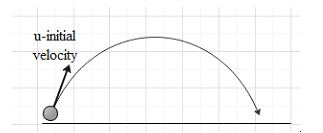
What is a projectile? Give examples.
Answer
574.5k+ views
Hint: When we hit a cricket ball with a bat, the ball will travel a curved path before finally falling into the ground. This is the basics of a projectile motion. Any particle moving through a curved path with a velocity at an angle to the horizontal will have projectile motion.
Complete step by step answer:
When a particle is thrown at an angle with the earth’s surface, the particle follows a curved path before falling into the ground. This is called the projectile motion. The path that the particle follows is called the projectile and the motion of the particle is called the projectile motion.
In projectile motion, the velocity of the particle can be broken into its component along the x-axis and the y-axis. The velocity along the x-axis gives the horizontal motion of the particle and the velocity of the particle along y-axis gives the vertical motion of the particle.
When the particle moves in the projectile, the only acceleration acting on the particle is the acceleration due to gravity. The acceleration due to gravity acts on the particle in the vertical direction. In the horizontal direction, no acceleration acts on the particle.

Consider throwing a ball at angle with the horizontal or the surface of the earth. The ball will travel in a curved path before falling into the ground. This motion is projectile motion and the path the ball travers is called the projectile of the ball.
Note:
We can use the basic kinematic equation on a projectile motion by breaking the velocity of the projectile into its vertical and horizontal components. From this we can find the equation of motion, maximum height, range of the projectile.
Complete step by step answer:
When a particle is thrown at an angle with the earth’s surface, the particle follows a curved path before falling into the ground. This is called the projectile motion. The path that the particle follows is called the projectile and the motion of the particle is called the projectile motion.
In projectile motion, the velocity of the particle can be broken into its component along the x-axis and the y-axis. The velocity along the x-axis gives the horizontal motion of the particle and the velocity of the particle along y-axis gives the vertical motion of the particle.
When the particle moves in the projectile, the only acceleration acting on the particle is the acceleration due to gravity. The acceleration due to gravity acts on the particle in the vertical direction. In the horizontal direction, no acceleration acts on the particle.

Consider throwing a ball at angle with the horizontal or the surface of the earth. The ball will travel in a curved path before falling into the ground. This motion is projectile motion and the path the ball travers is called the projectile of the ball.
Note:
We can use the basic kinematic equation on a projectile motion by breaking the velocity of the projectile into its vertical and horizontal components. From this we can find the equation of motion, maximum height, range of the projectile.
Recently Updated Pages
Why are manures considered better than fertilizers class 11 biology CBSE

Find the coordinates of the midpoint of the line segment class 11 maths CBSE

Distinguish between static friction limiting friction class 11 physics CBSE

The Chairman of the constituent Assembly was A Jawaharlal class 11 social science CBSE

The first National Commission on Labour NCL submitted class 11 social science CBSE

Number of all subshell of n + l 7 is A 4 B 5 C 6 D class 11 chemistry CBSE

Trending doubts
What is meant by exothermic and endothermic reactions class 11 chemistry CBSE

10 examples of friction in our daily life

One Metric ton is equal to kg A 10000 B 1000 C 100 class 11 physics CBSE

1 Quintal is equal to a 110 kg b 10 kg c 100kg d 1000 class 11 physics CBSE

Difference Between Prokaryotic Cells and Eukaryotic Cells

What are Quantum numbers Explain the quantum number class 11 chemistry CBSE




